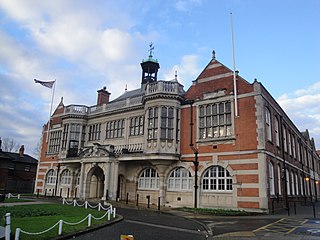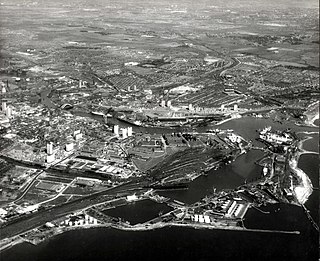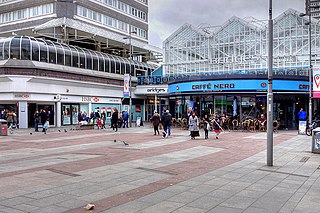
Sunderland City Centre is the central business district in Sunderland, Tyne and Wear, England. [1] The city centre is just to the west of Sunderland Docks.

Sunderland City Centre is the central business district in Sunderland, Tyne and Wear, England. [1] The city centre is just to the west of Sunderland Docks.
In 2020 it was announced that 14 million would be spent on a new car park in the city centre. [2]
This section needs additional citations for verification .(May 2023) |

The city centre’s main area, it extends south from the Wear to the A1231, including Sunderland's major shops. It contains the market square, Elephant Tea Rooms, Sunderland station, High Street West and the The Bridges Shopping Centre. The former Sunderland Civic Centre site is being redeveloped.
Monkwearmouth is north of the River Wear. It is best known for being the home of the Stadium of Light, St Peter’s Church and the University of Sunderland St Peter’s campus. The area is mainly made up of residential properties and light industry, and to the znorth merges into outer residential areas.
Bishopwearmouth is the western end of the centre. Known for being the home of the city hall, magistrates court, Keel Square, minster and the University of Sunderland city campus. The area’s west merges into outer residential areas.
Hendon is the centre’s east end. It is home to the Town Moor, Sunderland Docks and the former Sunderland Barracks. The area’s north is also called the East End while to the south it merges into outer residential areas.
Sunniside is the centre’s closest residential area. With merchant terraces and Mowbray Park to the south. It extents from Fawcett Street to the A1018. The area contains Sunderland Empire Theatre and the Sunderland Museum and Winter Gardens.
Sunderland City Centre is part of the Sunderland Central parliamentary constituency.
For local elections, it is currently divided between three wards of the city council. The majority of the city centre, lying to the west of Fawcett Street and the north of Holmeside, is located in Millfield ward. The eastern parts of the centre beyond Fawcett Street form part of Hendon ward, while the south of the city centre around Park Lane is within St Michael's ward.

Hendon is an urban area in the Borough of Barnet, northwest London 7 miles (11 km) northwest of Charing Cross. Hendon was an ancient manor and parish in the county of Middlesex and a former borough, the Municipal Borough of Hendon; it has been part of Greater London since 1965. Hendon falls almost entirely within the NW4 postcode, while the West Hendon part falls in NW9. Colindale to the northwest was once considered part of Hendon but is today separated by the M1 motorway.

Tyne and Wear is a metropolitan and ceremonial county in North East England.

Sunderland is a port city in Tyne and Wear, England. It is the City of Sunderland's administrative centre and in the historic county of Durham. The city is 10 miles (16 km) from Newcastle-upon-Tyne and is on the River Wear's mouth to the North Sea. The river also flows through Durham roughly 12 miles (19 km) south-west of Sunderland City Centre. It is the only other city in the county and the second largest settlement in the North East after Newcastle upon Tyne.

The City of Sunderland is a metropolitan borough with city status in the metropolitan county of Tyne and Wear, North East England. It is named after its largest settlement, Sunderland, spanning a far larger area, including nearby towns including Washington, Hetton-le-Hole and Houghton-le-Spring, as well as the surrounding suburban villages. The district also forms a large majority of Wearside which includes Chester-le-Street in County Durham.

Roker is a tourist resort and affluent area of Sunderland, North East England, bounded on the south by the River Wear and Monkwearmouth, on the east by the North Sea, to the west by Fulwell and on the north by Seaburn. It is administered as part of the City of Sunderland and lies within historic County Durham.

Hartcliffe is the name of both a council ward and an Outer Suburb of the city of Bristol in the United Kingdom which lies within that ward. The ward contains the areas of Hartcliffe and Headley Park, as well as small portions of Withywood and Bishopsworth.
Dunedin is a city of 130,400 people in the South Island of New Zealand. The principal suburbs of Dunedin are as follows. Inner and outer suburbs are ordered by location, clockwise from the city centre, starting due north:
This article is about the many neighborhoods and districts in the Greater Richmond, Virginia area. Note that this article is an attempt to be inclusive of the broader definitions of the areas which are often considered part of the Greater Richmond Region, based on their urban or suburban character and nature, rather than by strictly political boundaries.

Leicester City Centre is Leicester's historical commercial, cultural and transport hub and is home to its central business district. Its inner core is roughly delineated by the A594, Leicester's inner ring road, although the various central campuses of the University of Leicester, De Monfort University and Leicester College are adjacent to the inner ring road and could be considered to be a continuation of the City centre. In a similar way, the Leicester Royal Infirmary precinct, the New Walk business district (Southfields), the Welford Road Stadium of Leicester Tigers' RUFC and the King Power Stadium of Premier League Leicester City to the south, and the Golden Mile to the north could also be deemed to be extensions to the central core.

Hendon is an eastern area of Sunderland in Tyne and Wear, North East England, the location of much heavy industry and Victorian terraces and three high-rise residential tower blocks. The area is commonly referred to as the East End of Sunderland. Hendon is west of Sunderland Docks.
Swansea city centre in Swansea, Wales, contains the main shopping, leisure and nightlife district in Swansea. The city centre covers much of the Castle ward including the area around Oxford Street, Castle Square, and the Quadrant Shopping Centre; Alexandra Road, High Street, Wind Street and the Castle; Parc Tawe; and the Maritime Quarter extending down to the seafront.
Grangetown is a suburb of Sunderland in Tyne and Wear, England. It is situated two miles south of Sunderland City Centre and two miles north of Ryhope. Grangetown was previously known for heavy traffic congestion, as it contained the intersection of the original route of the A1018 road and the inner and outer ring roads. Since the opening of the new Southern Radial Route in mid-2008, traffic has become less of an issue in the area. Grangetown is home to many shops and is a popular shopping place for locals. It contains Grangetown Primary School and Southmoor Academy. The borders of Grangetown are Hillview to the west, the sea to the east, Hendon and Ashbrooke to the north and Ryhope to the south. Some main roads in Grangetown are Leechmere Road, Ryhope Road, Queen Alexandra Road and Sea View Road. Sea View Road is a very affluent road in Grangetown and has large houses on the main road and semi-detached houses, detached houses and bungalows on the culs de sacs off it. Sea View Road is home to Sea View House a large family home.

Sunderland is a railway and metro station in Sunderland, Tyne and Wear, England. It is on the Durham Coast Line, which runs via Hartlepool and the city between Middlesbrough and Newcastle. It is owned by Network Rail and managed by Northern Trains. Since 31 March 2002, the station has also been served by the Tyne and Wear Metro's Green Line.

Cabot was a council ward that covered the centre of Bristol, England. It took its name from the Cabot Tower, a memorial tower on Brandon Hill that was built to commemorate John Cabot's voyage and "discovery" of North America. The ward was abolished in 2016.


Elections to the Preston City Council took place on 3 May 2007.

The A1231 road connects Sunderland and Washington in Tyne and Wear, North East England. It is the main road connecting these towns and is one of the main roads giving access to Sunderland city centre.

The A1018 is a road in North East England. It runs between South Shields, at the mouth of the River Tyne, and the A19 near Seaham, County Durham. Most of the route it follows is the old alignment of the A19, before it by-passed Sunderland to meet the Tyne Tunnel.

The Bridges Shopping Centre, commonly known as ‘The Bridges’ is a shopping centre located in Sunderland, England. The centre was opened by Princess Royal, Anne in 1988.

In 685, King Ecgfrith granted Benedict Biscop a "sunder-land". Also in 685 The Venerable Bede moved to the newly founded Jarrow monastery. He had started his monastic career at Monkwearmouth monastery and later wrote that he was "ácenned on sundorlande þæs ylcan mynstres". This can be taken as "sundorlande" or the settlement of Sunderland. Alternatively, it is possible that Sunderland was later named in honour of Bede's connections to the area by people familiar with this statement of his.